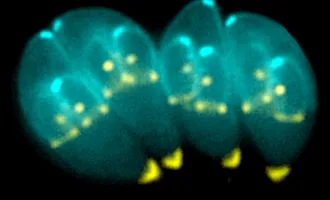Hacking Cells to Prevent Obesity
Your fat is alive. Your fat is alive and it is talking. It is listening. It is reading its DNA and deciding what to make. It is coordinating more complex processes than an air traffic controller. It is smarter than Matt Damon in The Martian.
Your fat consists of fat cells, which biologists call adipocytes. Adipocytes do lots of things that all cells do and some things that only adipocytes do. Most adipocytes store lipid droplets, little reservoirs of fat. Other adipocytes are specialized to generate heat. These are more common in newborns and hibernating mammals, keeping them cozy.
Recently, scientists at UCSF and UCSD have discovered a little trick with adipocytes in mice. According to the paper by lead author Dr. Bernat Baeza-Raja, from Dr. Katerina Akassoglou’s lab at the Gladstone Institutes, and published in the January 12th edition of Cell Reports, removing one gene, a specific receptor found on the surface of adipocytes (as well as other cells), prevents these mice from becoming obese when fed a high-fat diet.
We tend to think of obesity in the most reductive terms. Too much in, not enough out: human gets big. This view is out of line with the complexity of cellular processes that characterize all cells, including fat cells.
Most cases of obesity are associated with a more systemic problem called “metabolic syndrome.” Yes, some of the main risk factors for metabolic syndrome are diet, sedentary behavior, and alcohol use, but the effect is more damaging and complicated than overfilling a storage tank: fatty molecules begin circulating in the blood in higher amounts, blood pressure increases, and high density cholesterol (the “good” cholesterol) decreases.
Metabolic syndrome, which affects an alarming 34% of the U.S. adult population, quintuples the risk of developing type 2 diabetes, in which cells become resistant to insulin. Metabolic syndrome is also found in 50% of patients with coronary heart disease.
Yet removing one cell surface receptor from mice changes things dramatically. The receptor is p75 neurotrophin receptor (p75NTR). Neurotrophins are proteins that tell neurons to survive and grow by binding to receptors like p75. Strangely, removing p75NTR from every cell in the mouse (a “global deletion”) yielded mice that were not only alive but were obesity-resistant.
The researchers took normal mice and mice with the p75NTR deletion and fed them the same high fat diet (60% of calories coming from fat). The normal mice became obese and resistant to insulin. Essentially they were type 2 diabetics.
The mice with the p75NTR deletion ate the same toothsome, high-fat grub in the same amounts, but remained slim and displayed normal insulin sensitivity. They didn’t started running ultra-marathons – they showed the same activity levels as normal mice. Instead, their metabolism churned like a blender blade, sucking in oxygen and spitting out CO2 at rates far exceeding their genetically normal acquaintances.
Baeza-Raja and colleagues tinkered with the cellular machinery of adipocytes to find out what was going on. Beyond its role in neurons, they saw that p75NTR is found on many cell types, including adipocytes, where a high-fat diet actually triggers the production of more p75NTR in obese mice. p75NTR crosses the cell membrane, and the arm it extends inside the cell attaches to a protein called PKA, holding it inactive. When p75NTR releases its grip, PKA sends signals throughout the cell with different outputs. One output is lipolysis, or the breaking down of fat molecules.
Without p75NTR putting a check on PKA, adipocytes go to town on any fat they can burn. But since p75NTR is found on many cell types, and especially has a role for neurons, the researchers wanted to show that its activity specifically in adipocytes accounted for the development of obesity, that it’s not causing a nervous system change or hormonal change in another organ.
Deleting a gene from every cell in a mouse is not too hard. You target the embryo at the earliest stage, and then every cell that grows out from that core will also lack the gene. Deleting a gene from specific tissues or cell types is slightly next-level, but is done routinely. The technique relies on a protein called Cre recombinase and the fact that some regions of DNA are only turned on in specific cell types.
The UCSF/UCSD team deleted p75NTR in just the mice adipocytes and saw the same effect: no obesity, no insulin resistance. This result added to the potential of p75NTR to be a drug target for obesity and metabolic syndrome.
Imagine: a pill full of molecules, each one a lean, sexy adipocyte fitness trainer. Let your fat cells feel the burn and you don’t have to.



